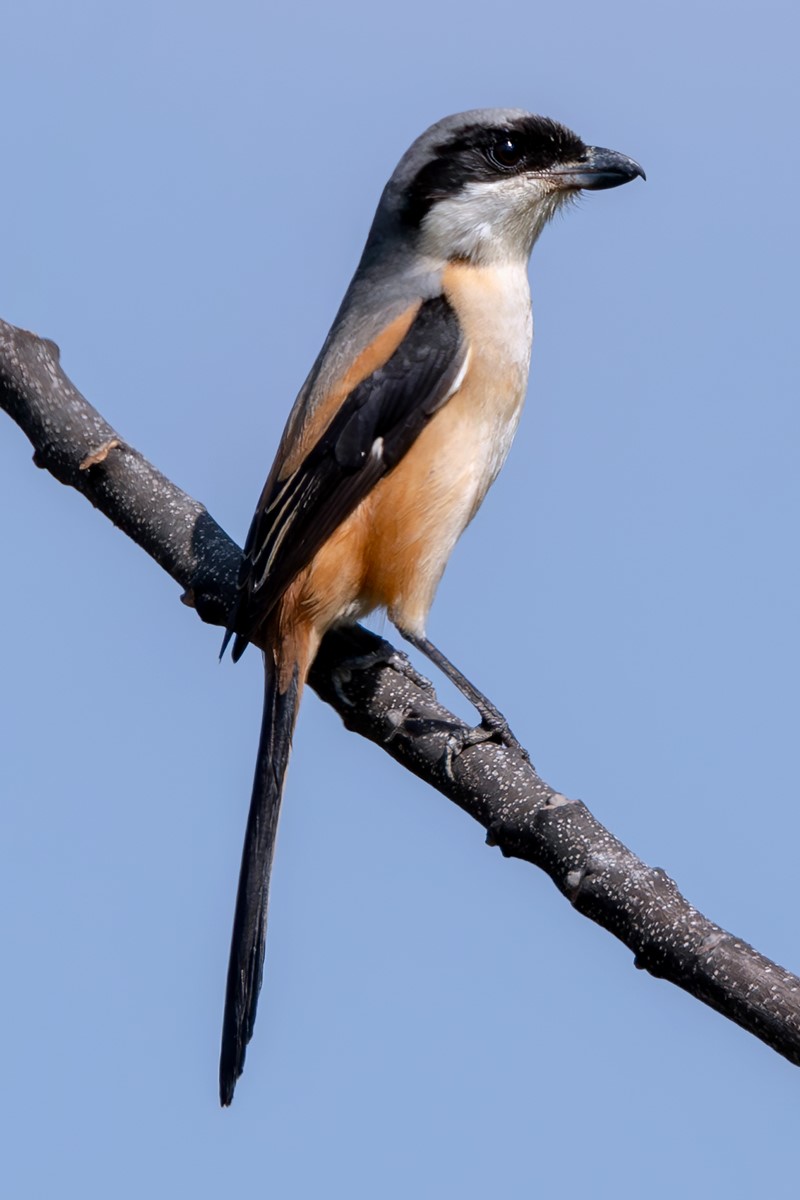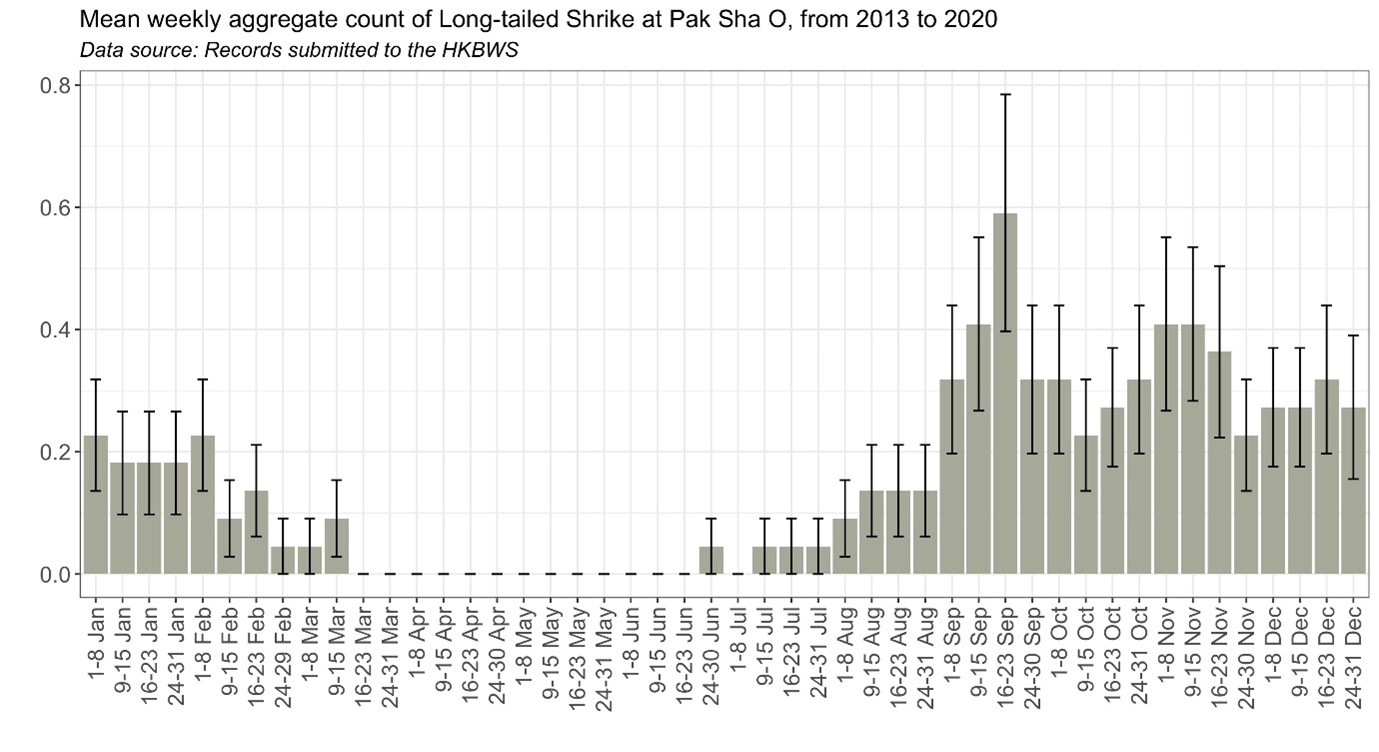Long-tailed Shrike Lanius schach 棕背伯勞
Category I. Common breeding resident in open-canopy shrubland and open-country with sufficient perches and nest sites.
IDENTIFICATION

Jan. 2023, Michelle and Peter Wong.
20-25 cm. Medium-sized shrike with long tail. Broad facial mask black, crown to mantle dark grey, back and rump rufous, upperwing blackish, white patch at base of primaries, tail black, underparts whitish with rufous flanks. Sexes similar, though male tends to be more richly coloured.
Juvenile has less extensive facial mask, brownish-grey upperparts with prominent dark barring, whitish underparts with rufous wash and dark vermiculation.

Nov. 2004, John and Jemi Holmes.
Melanistic form “fuscatus” has most of head, wing and tail black, rest of plumage dark grey. Birds intermediate in plumage also occur.
VOCALISATIONS
In general these are loud and distinctive. The song, which often contains mimicry, is a mishmash of harsh and grating notes and is distinctive for its volume. Mimicry of starlings and drongos is frequent, particularly Crested Myna.
The calls most often heard include a series of harsh, grating ‘ki-kyip’, ‘kyew’ or ‘kyee’ notes, which appear to be mainly uttered as a territorial marker in the non-breeding season, often early morning. Also an explosive ‘kyow’ and a less grating ‘kee-yoo’.
Xeno-canto does not allow free access to recordings that have been uploaded to the site.
DISTRIBUTION & HABITAT PREFERENCE
Favours a wide range of open habitats where hunting and song posts are available with suitable cover for nesting, such as agricultural land, fish pond areas, abandoned fields with shrubby vegetation, airfields, golf courses and wetland habitats except mangrove. Avoids the centre of closed-canopy forest and shrubland and degraded grassland that lacks perches. Tolerant of a moderate level of disturbance, it can occur in marginal agricultural land in villages and open storage areas, but it is uncommon in urban areas, even large parks and open spaces. It is largely absent from HK and Cheung Chau islands (considered to be due to the dominance of closed-canopy habitat) and appears to be mainly a non-breeding visitor on Lamma.
Although it remains a common and widespread species, especially in the northern New Territories, the decline of open habitat in HK has reduced its range in both breeding and non-breeding seasons. Occupancy decreased from 33.9% to 11.4% of 1km squares as measured by the breeding bird surveys of 1993-96 and 2016-19. It disappeared from many parts of the northern and central New Territories, Sai Kung, HK Island, Lantau, Lamma and some smaller offshore islands. This is presumably associated with the increase in closed-canopy shrubland and forest in the New Territories and on HK Island, as well as urban development in Yuen Long, Tuen Mun, Tai Po and Tung Chung in the same period. A reduction in agricultural activity is possibly another reason explaining the decline, especially in the northern and central New Territories, e.g., Sheung Shui, Kam Tin and Lam Tsuen valley.
A less dramatic decline in distribution was observed in winter, when it appears slightly more flexible in its habitat requirements. The percentage of 1 km squares in which it was recorded decreased from 30.6% to 17.7% between the winter atlas of 2001-05 and that of 2016-19. The pattern of decrease was similar to that in breeding bird surveys, especially in the northern New Territories.
During the 1960s breeding birds were widespread in the western part of HK Island, and until the late 1970s apparent passage or wintering birds occurred in less densely developed locations in the urban areas such as Kai Tak, Kowloon Tong and King’s Park, as well as Mid-Levels and Pok Fu Lam on HK Island. From December 1968 to January 1969 there were even records from Victoria Barracks (now HK Park) and the former Government House in the heart of Central. At Mount Nicholson, HK Island, where continuous records were maintained from 1978 to 1995, regular records of Long-tailed Shrike ceased after 1982, but occasional birds continued to be noted, primarily in autumn, until at least 1992 (Viney 1995). During this period there was both an extension of the urban area and an almost complete disappearance of open areas around its fringes, as both the hillsides of HK Island and Kowloon Hills developed shrubland and woodland cover thus rendering them unsuitable for this species. Since open areas do still exist in the urban parks, and these are still utilised by Brown Shrikes during passage and occasionally in winter, it is surmised that the former records of Long-tailed Shrikes in these locations were of dispersing birds rather than true migrants, and that the breeding areas are now too distant for such dispersal to occur. A decline on Cheung Chau, where the species disappeared in 1994, may have similar causes. Conversely, it is now a regular breeding species at Mai Po NR where it was absent during the summer months up to 1987. Presumably tree planting and shrub growth along footpaths and gei wai bunds has provided suitable breeding habitat.
OCCURRENCE
In most areas where breeding occurs, the number of birds is rather stable throughout the year, with a slight decrease in spring and an increase in summer probably due to breeding activities (Figure 1). However, post-breeding dispersal is evident in areas where it does not breed. Thus, regular surveys from 2012 to 2020 of Pak Sha O, an area comprising largely closed-canopy woodland and shrubland, indicated that dispersing birds appeared in the very small area of dry agricultural land present in the last week of June or early July and remained through the winter (Figure 2).
The melanistic form is widespread but occurs in much smaller numbers than typical birds. At Mai Po, where 52 birds were trapped during 1985-1996, only two (3.8%) were of the melanistic form.
Long-tailed Shrike was described as “very numerous everywhere” by Swinhoe (1861), which was echoed by later observers (Vaughan and Jones 1913; Hutson 1930; Herklots 1953).
BREEDING
The breeding season extends from mid-March to the end of July. Fledging begins to occur in mid-April but has been noted as late as July, presumably indicating a second brood. Cup-shaped nests are typically placed in bushes, trees or bamboo clumps (Herklots 1953). Breeding activity occurs in most of its range.
BEHAVIOUR, FORAGING & DIET
Mostly occurs in ones or twos. Perches prominently, often on overhead wires, tree tops, post-like structures etc. Territorial throughout the year, usually marked by early morning vocalising. Despite its common status, there are few data regarding diet. It preys on smaller birds such as Eurasian Tree Sparrow, Cinereous Tit, Scaly-breasted Munia, as well as insects (Orthoptera).
RANGE & SYSTEMATICS
Of the nine subspecies, L. s. schach and L. s. tricolor occur in China, and both are considered resident (Liu and Chen 2020). While L. s. tricolor is restricted to south Xizang and Yunnan, the nominate race occurs in central, south and southeast mainland China (including HK), Hainan, Taiwan and north Vietnam (Yosef et al. 2020).
CONSERVATION STATUS
IUCN: Least Concern. Population trend unknown.
Figure 1.

Figure 2.

Herklots, G. A. C. (1953). Hong Kong Birds. South China Morning Post, Hong Kong. (2nd. Ed. 1967 (1974)).
Hutson, H. P. W. (1930). The birds of Hong Kong. Laniidae (Shrikes). Hong Kong Naturalist 1:147-150.
Liu, Y. and Y. H. Chen (eds) (2020). The CNG Field Guide to the Birds of China (in Chinese). Hunan Science and Technology Publication House, Changsha.
Swinhoe, R. (1861). Notes on the ornithology of Hong Kong, Macao and Canton, made during the latter end of February, March, April, and the beginning of May 1860. Ibis 1861: 23-57.
Vaughan, R. E. and K. H. Jones (1913). The birds of Hong Kong, Macao and the West River or Si Kiang in South-East China, with special reference to their nidification and seasonal movements. Ibis 1913: 17-76, 163-201, 351-384.
Viney, C. A. (1996). Mount Nicholson – Hong Kong – 1978-1995 – a natural history. Privately publd. by author, Hong Kong.
Yosef, R., ISWG International Shrike Working Group and E. de Juana (2020). Long-tailed Shrike (Lanius schach), version 1.0. In Birds of the World (J. del Hoyo, A. Elliott, J. Sargatal, D. A. Christie, and E. de Juana, Editors). Cornell Lab of Ornithology, Ithaca, NY, USA. https://doi.org/10.2173/bow.lotshr1.01

